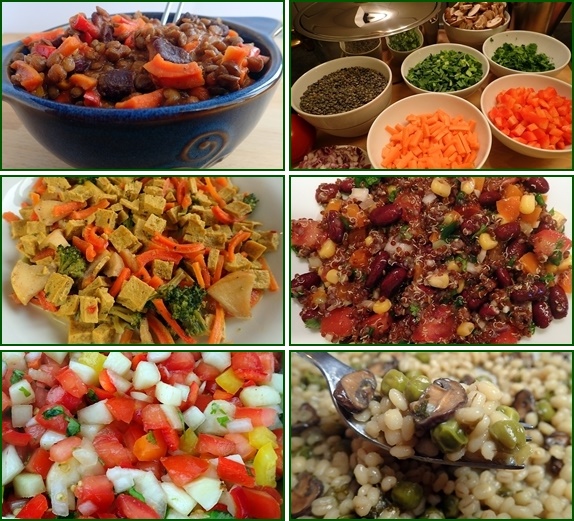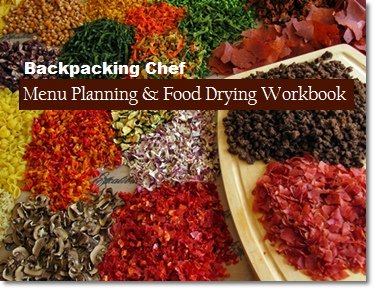36 Vegan & Vegetarian Backpacking Meals
The recipes in this collection were designed as vegan and vegetarian backpacking meals. Many other recipes on the website that include meat can be easily modified for vegetarians by substituting dehydrated tofu, beans, chickpeas, green lentils, or Beyond Burger for the meat component.
For example, the Unstuffed Peppers recipe normally includes ¼ cup of dried ground beef. To make it a vegan and vegetarian backpacking meal, substitute dried green-lentil chili for the ground beef.
You’ll find the the Green-Lentil Chili recipe and more on this page, plus a table of contents listing twenty more recipes for vegetarian backpacking meals.
Vegetarian Backpacking Meals on this Page:
31 Vegan and Vegetarian Backpacking Meals on Backpacking Chef:
Tofu Recipes:
Tofu Noodles with Vegetables & Rice, Tofu Vegetable Soup, Spicy Tofu Tortillas, and Curry Tofu & Vegetables.
Explore: Dehydrating Tofu Recipes.
Cold-Soak Vegetarian Backpacking Meals:
Peach Salsa Rice Salad, Apricot-Mint Salsa Rice Salad, Quinoa & Bean Cilantro Salad, Couscous Salad with Cucumber-Salsa Dressing, and Edamame Hummus Tortillas.
Explore: No-cook Backpacking Meals.
Oldies but Goodies:
Kickin’ Veggie Mac & Cheese (not vegan)
Easy Cheesy Rice & Beans (not vegan)
Vegetarian Backpacking Meals using Dehydrated Beyond Burger:
Beyond Burger Chili, Unstuffed Peppers, and Taco Tortillas.
Explore: Plant-Based Hiking Food Recipes.
Vegetarian Backpacking Meals using Textured Vegetable Protein (TVP):
TVP Chili, Unstuffed Peppers with TVP, Mac & Veggies with TVP, and Curry Rice & Veggies with TVP.
Explore: Textured Vegetable Protein Recipes.
Vegetarian Backpacking Meals with Lentils:
Lentils & Vegetables with Rice, Lentil Surprise Stew, Red Lentil Curry, and Indian Dal.
Explore: Backpacking Lentil Recipes.
Also: Green Lentil Stew
Vegan & Vegetarian Backpacking Recipes featured in Trail Bytes:
Barley Risotto with Peas & Mushrooms
Subscribe to Trail Bytes (comes with free e-book)
Do you have any recipes for vegan or vegetarian backpacking meals you’d like to share? Share a recipe.
Vegetarian Unstuffed Peppers
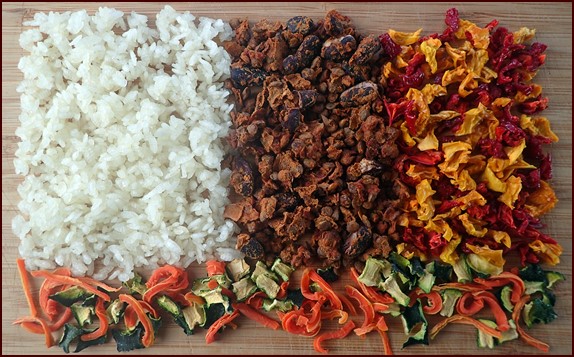
Photo: Dehydrated ingredients for Vegetarian Unstuffed Peppers. Green-Lentil Chili in center.
Servings: 1
Ingredients:
- ½ cup dried rice (55 g)
- ¼ cup dried green-lentil chili (25 g)
- ¼ cup dried bell peppers (15 g)
- 1 Tbsp. dried carrots (5 g)
- 1 Tbsp. dried zucchini (5 g)
- 2 Tbsp. tomato sauce leather or 1 Tbsp. tomato sauce powder (10 g)
- 2 cups water to rehydrate
On the Trail:
Combine all ingredients with water and soak 5 minutes. Light stove, bring to a boil for one minute, then transfer pot to an insulating pot cozy. Wait 20 minutes or longer for best results.
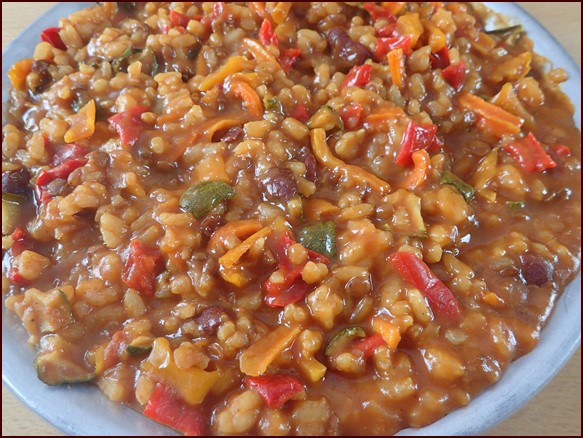
Photo: Rehydrated Vegetarian Unstuffed Peppers. You're going to love this vegetarian backpacking meal!
Green-Lentil Chili
Featured in Recipes for Adventure II: The Best of Trail Bytes.
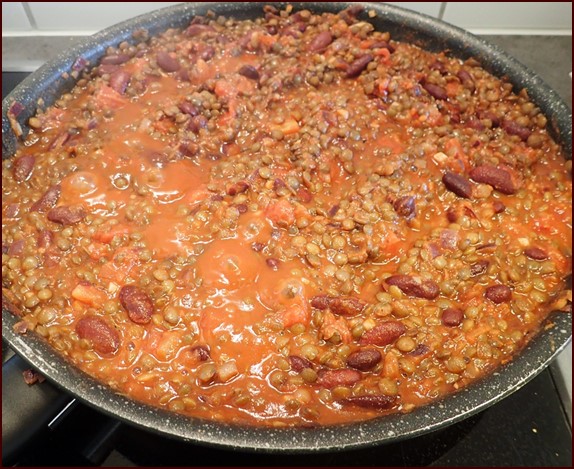
Servings: 4
Ingredients:
- 1½ cups green lentils (300g)
- 1 15-oz. can diced tomatoes (400 g)
- 1 15-oz. can kidney beans (400 g)
- 2 medium onions, diced (130 g)
- ½ Tbsp. cooking oil
- 2–3 cloves garlic, minced
- 3 Tbsp. tomato paste
- 3 Tbsp. chili mix powder
- 1½ tsp. salt
- 1 tsp. ground cumin
- ¼ tsp. pepper
- ½ tsp. oregano
- 2 bay leaves
- 3 Tbsp. brewed coffee (optional)
- 3 Tbsp. apple-cider vinegar
Dehydrate Separately:
- 6–8 carrots
- 3–4 bell peppers
At Home: Cooking Green-Lentil Chili
Green lentils were used for this recipe because they stay firm when cooked. Red lentils tend to get mushy.
Rinse lentils first to remove any dust or debris.
In a stockpot, bring lentils to a boil in 4 cups of water or bullion (800 ml) seasoned with bay leaves and ground cumin. Do not add salt yet, as salt on the front end makes lentils tougher. Reduce heat, and simmer for 30 minutes.
When the lentils are almost done, start cooking the other ingredients in a separate pan.
Coat pan with minimal cooking oil, and cook onions and garlic for 5 minutes on medium heat.
Add all the dry seasonings and the tomato paste. Continue stirring a few more minutes.
Add the cooked lentils, rinsed kidney beans, diced tomatoes, and brewed coffee (optional) to the pan. Increase heat until bubbling, and then reduce to a low simmer for 30 minutes.
Adjust seasonings to taste during the last 5 minutes of cooking. Remove chili from stove and stir in the apple-cider vinegar. Balsamic vinegar may be used in place of apple-cider vinegar.
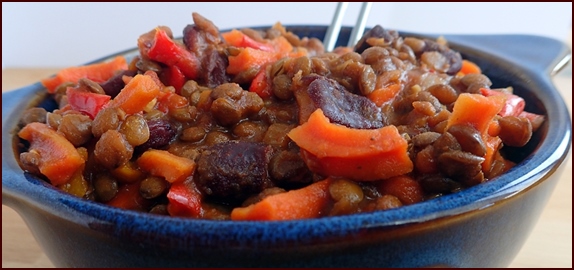
Photo: Rehydrated Green-Lentil Chili.
Dehydrating Green-Lentil Chili
Dehydrate at 135°F (57°C) for 8–10 hours or until crispy.
This recipe makes 6 cups of chili (wet). If using an Excalibur Dehydrator, 2 cups of chili will fit nicely on each of 3 trays covered with nonstick sheets.
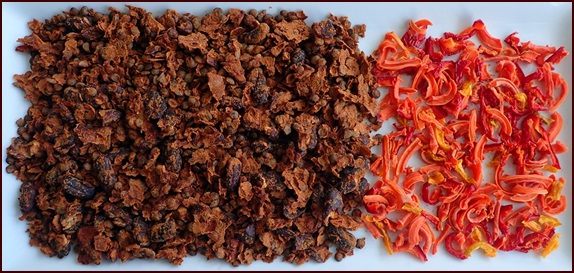
Photo: One serving of dried Green-Lentil Chili and Vegetables.
Dehydrating Extra Vegetables
Carrots and bell peppers can be cooked in the chili, but they tend to lose some color and texture when stewed. To achieve better color and texture, dry them separately, and add them to the meal later.
Steam carrots for 6 minutes before drying them. They will turn dark orange and hold their color better than if dried raw. Bell peppers can be dried raw. Dehydrate at the same time as the chili.
On the Trail:
Servings: 1 Large
Ingredients:
- 1 cup green-lentil chili (112 g)
- ¼ cup dried vegetables (20 g)
- 1¾ cups water to rehydrate (414 ml)
Pot Cooking: Combine chili and vegetables in pot with water. If you like your chili saucy, add a bit more water. Soak 5 minutes, and bring to a boil for 1 minute. Transfer pot to an insulating cozy for 15 minutes.
Thermos Cooking: Use an extra ¼ cup of water. Add 2 cups of boiled water (473 ml) to ingredients in a thermos food jar. Wait 20 minutes, up to several hours.
Ratatouille
This vegan and vegetarian backpacking meal is featured in Recipes for Adventure: Healthy, Hearty & Homemade Backpacking Recipes.
Ratatouille is a traditional French vegetable stew featuring eggplant, zucchini, bell peppers, tomatoes, onions, and garlic—seasoned with Herbes de Provence. Enjoy as a main course or combine with rice.
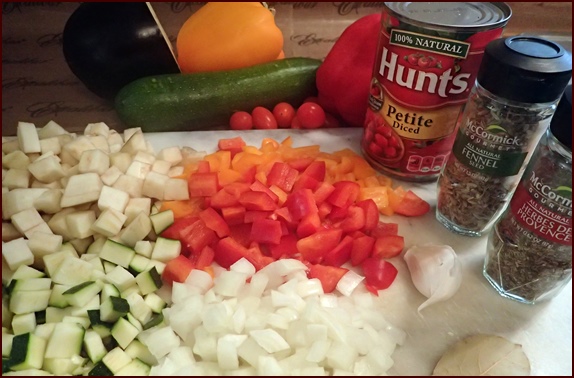
At Home:
Servings: 3–5
Ingredients:
- 1 eggplant, diced
- 1 Tbsp. cooking oil
- 2 onions, diced
- 1 red bell pepper, diced
- 1 yellow bell pepper, diced
- 2 cloves garlic, minced
- 1 tsp. fennel seeds
- 2 bay leaves
- 1 tsp. Herbes de Provence
- 2 small zucchini, diced
- 2 cups fresh tomatoes, diced, or 14.5 oz. can
Peel the eggplant. Before dicing, cut the eggplant into half inch slices. Squeeze or press eggplant slices gently between paper towels to remove excess liquid which can taste slightly bitter. Dice eggplant and other vegetables into small pieces. If you were not planning to dehydrate this vegetarian backpacking meal, you could cut the vegetables into larger pieces.
In a large, non-stick skillet, heat the oil and sauté onions until translucent. Add garlic, bell peppers, fennel seeds, bay leaves, and Herbes de Provence, and sauté until bell peppers are soft.
Herbes de Provence typically contains rosemary, marjoram, basil, bay leaf, and thyme.
Add eggplant and sauté until it turns golden.
Add zucchini and sauté for another five minutes.
Add diced tomatoes, salt and pepper to taste, and turn the heat down to a simmer. Simmer for about fifteen minutes, until the tomatoes cook down. Let cool.
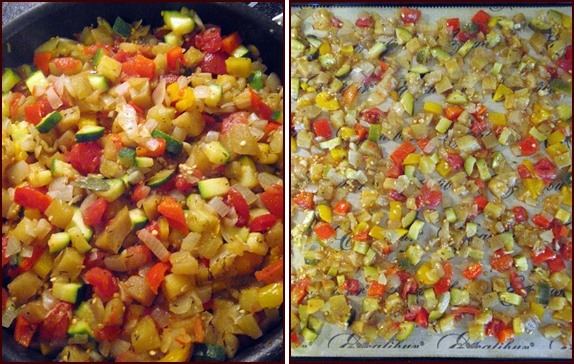
Dehydrating Ratatouille
Spread vegetables out in a single layer on dehydrator trays covered with nonstick sheets. Midway through the drying process, break-up any vegetables that are stuck together.
Dehydrate at 135°F (57°C) for approximately ten hours. You can speed up the drying process by starting out at 145°F (63°C) for the first two hours. Drying times may be longer for some dehydrators. Vegetables will be leathery when done with no moisture appearing when you cut into a piece.
Store in an air-tight container for longest shelf life. Divide into individual servings and place in zip-lock bags for trail use.
On the Trail:
Combine one cup ratatouille with one cup water in pot and soak for five minutes. For a larger serving, increase ratatouille and water by ½ cup each.
Light stove and bring to a boil. Once a full boil is reached, transfer pot to an insulating pot cozy for fifteen minutes.
To enjoy this meal with rice or macaroni, combine ½ cup ratatouille with either ½ cup precooked and dried rice, or ½ cup precooked and dried macaroni. Rehydrate and cook with one cup water if using rice, or 1¼ cups water if using macaroni.
Zucchini Ratatouille
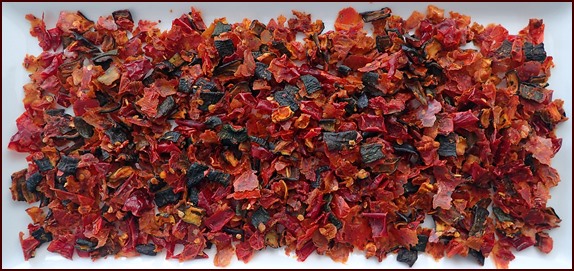
A similar vegetarian backpacking meal can be made without eggplant. See Zucchini Ratatouille Recipe.
Root Bark Stew
Featured in Recipes for Adventure: Healthy, Hearty & Homemade Backpacking Recipes.
Enjoy Root Bark Stew for trail meals, or munch on it dry as a snack while hiking. This vegetarian backpacking meal features sweet potatoes, parsnips, turnips, and rutabaga with Moroccan spices.
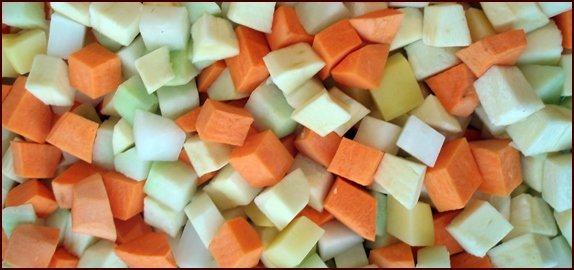
Photo: Diced Sweet Potatoes, Parsnips, Turnips, Rutabaga
At Home:
Servings: 3–4
Ingredients:
- 1 Tbsp. cooking oil
- 2 medium onions, chopped
- 2 cloves garlic, minced
- 1 large sweet potato, diced
- 1 lb. parsnips, diced
- 3 medium turnips, diced
- 1 large rutabaga, diced
- ¼ cup raisins
- 16–32 oz. vegetable broth
- 1 14.5 oz. can diced tomatoes, drained
- 1 Tbsp. curry powder
- 1 Tbsp. ground cumin
- 1 tsp. cinnamon
- Salt and pepper to taste
Peel and cut roots into ½ inch cubes or slightly smaller.
In a nonstick pan, heat oil over medium-high heat. Add onion and sauté until golden; about five minutes. Add garlic, curry, cumin, cinnamon and a splash of broth. Stir another minute.
In a large pot, add cubed sweet potatoes, parsnips, turnips, rutabaga, raisins, and the sautéd onions and garlic from the pan. Add just enough broth to cover the root vegetables. You will probably use closer to 16 ounces of broth than 32 ounces.
Bring to boil, reduce heat, cover, and simmer until vegetables are tender; about ten minutes.
Add diced tomatoes and salt and pepper to taste; simmer five more minutes.
Dehydrating Root Bark Stew
In order to capture the wonderful flavors in the broth, combine the broth with a portion of the cooked roots and turn it into bark as follows:
Drain off broth into a pot. An easy way to drain the broth is to pour the contents from your cook pot through a colander positioned over another pot. Add broth plus four cups of the cooked roots to a blender and blend until smooth.
Spread blended roots thinly (¼” thick) on dehydrator trays covered with nonstick sheets. Dehydrate at 135°F (57°C). The bark will dry in about eight hours and will easily break into pieces. Dry a little longer if the bark tears rather than breaks.
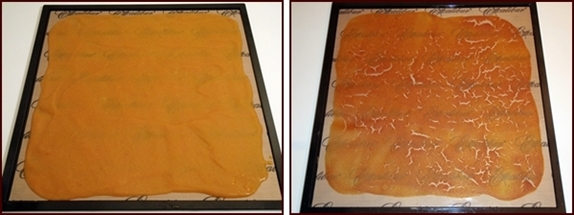
Photo: Root Bark on dehydrator trays before and after.
Arrange remaining cooked roots on trays with nonstick sheets. Dehydrate at 135°F (57°C). The roots will dry in about twelve hours. Stir pieces midway, pulling apart any pieces that are stuck together. Roots will be pliable to hard when done with no moisture appearing when you cut into a piece.
With a large capacity dehydrator such as the 9-tray Excalibur Food Dehydrator, you can dry the bark and roots at the same time, leaving the pieces in the dehydrator for the extra four hours. Otherwise, you may have to dry the roots and bark in separate batches.
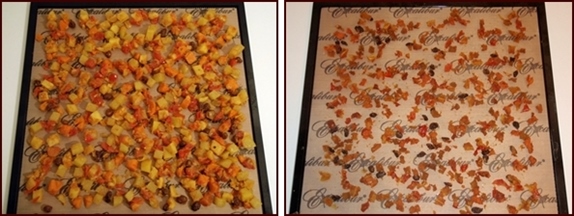
Photo: Roots on dehydrator trays before and after.
The yield from this vegetarian backpacking recipe will be approximately four cups of dried bark and two cups of dried roots. Combine the dried roots and bark to make stew, adding dried beans (or chicken for meat eaters) if desired. You can make a serving of mashed roots, which taste like spicy mashed potatoes, with any bark that is left over.
Let cool before storing in an airtight container. Combine roots and bark into individual vegetarian backpacking meals.
Make it a backpacking meal or side dish:
On the Trail:
Root Bark Stew
Servings: 1 (Makes a nice side dish)
- ¾ cup dried root pieces
- ¼ cup dried root bark
- 1 cup water to rehydrate
Mashed Root Bark
Servings: 1 (Makes a nice side dish)
- 1 cup dried root bark
- 1 cup water to rehydrate
Combine food with an equal amount of water in pot and soak five minutes.
Light stove, bring to boil, and cook for one more minute. Add a few more spoonfuls of water if you want a sauce with a thinner consistency. Transfer pot to an insulating pot cozy and wait 10–15 minutes.
Snacking Suggestion:
In addition to making a tasty vegetarian backpacking meal, root bark and the dried root vegetables taste great dry as snacks.
Curry-Carrot Soup
Featured in Recipes for Adventure II: The Best of Trail Bytes.
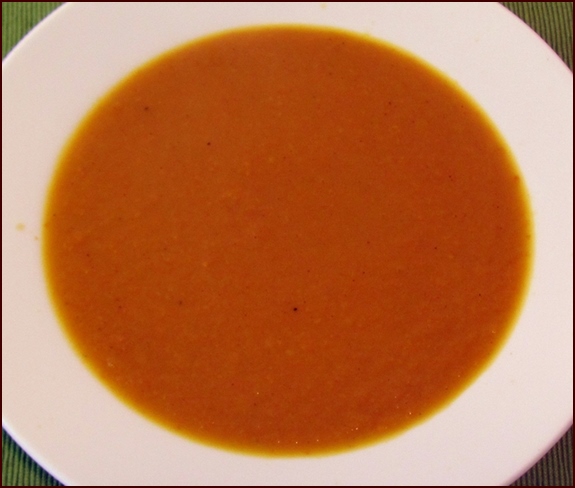
Servings: 6–7 cups
Ingredients:
- 1½ lb. carrots (680 g)
- ¾ lb. sweet potatoes (340 g)
- 1 medium onion (125 g)
- 3 cloves garlic (20 g)
- 2 Tbsp. tomato paste (35 g)
- 2 tsp. cooking oil
- 4 cups water (946 ml)
- Dry Seasonings:
- 3 Tbsp. curry powder
- 1½ tsp. salt
- ¼ tsp. pepper
- 1 tsp. ground ginger
- ½ tsp. red pepper flakes
- ½ tsp. paprika
At Home: Cooking Curry-Carrot Soup
Dice the onions, and mince the garlic.
Peel and slice the carrots thinly.
Peel and cut sweet potatoes into small cubes. Place sweet potato cubes in a bowl with water, then drain off water when ready to add cubes to the soup. This will prevent browning.
Combine all dry seasonings in a small bowl.
Coat the bottom of a large soup pot with 2 teaspoons of cooking oil. Begin sautéing onions on medium heat.
Add garlic after 5 minutes, and stir continuously for another minute.
Add the carrots, tomato paste, and all dry seasonings. When ingredients are well combined and steaming, add the sweet potato cubes and 4 cups of water.
Bring to a boil, and then reduce heat to maintain a low simmer. Continue cooking on low with lid on pot for 20 minutes.
Remove pot from heat, and allow the soup to cool.
Run the cooled soup through a blender.
Wet Yield: Approximately 6½ cups (1538 ml) of wet soup before drying.
Dehydrating Curry-Carrot Soup
Spread soup thinly on dehydrator trays covered with nonstick sheets. If using an Excalibur Dehydrator, that will amount to approximately 1¼ cups on each of 5 trays.
Dehydrate at 135°F (57°C) for 10–12 hours or until dry and crumbly.
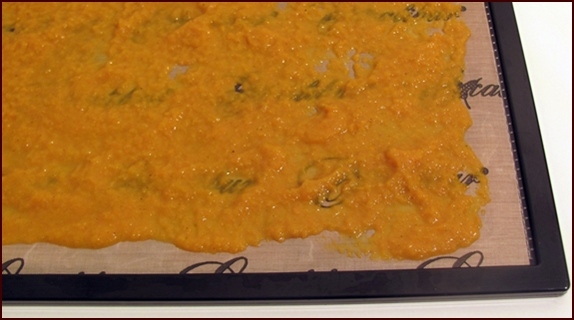
Dried soup will easily tear or crumble into small pieces. Reduce the pieces to powder in a blender.
Dried Yield: Approximately 18 tablespoons (216 g) of soup power (12 g each).
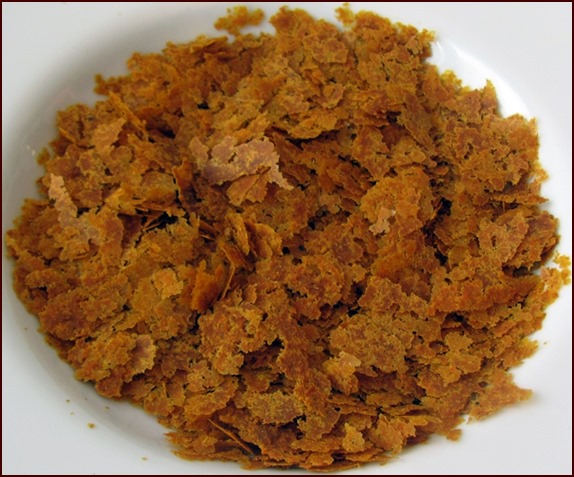
Photo: Dried Curry-Carrot Soup before blending into powder.
On the Trail:
Add 2 Tbsp. (24 g) of soup powder per cup (237 ml) of water.
Regular Serving: 3 Tbsp. soup powder (36 g), 1½ cups water (355 ml).
Large Serving: 4 Tbsp. soup powder (48 g), 2 cups water (473 ml).
Pot Cooking: Combine soup powder with water. Soak for 5 minutes, and then bring to a boil for 1 minute. Transfer pot to an insulating cozy for 15 minutes.
Thermos Cooking: Add boiled water to ingredients in thermos. Wait 20 minutes, up to several hours. Use ¼ cup extra boiled water for longer soak times; soup thickens.
Extra Ingredients: This vegetable-soup base will support the addition of virtually any combination of dried beans, tofu, or vegetables. Try this blend: 4 Tbsp. soup powder (48 g), ⅓ cup extra ingredients (24 g), 2⅓ cups boiled water (550 ml).
More Vegetarian Backpacking Soup Recipes
Recipes for Adventure II: The Best of Trail Bytes dedicates a whole chapter to dehydrated soups.
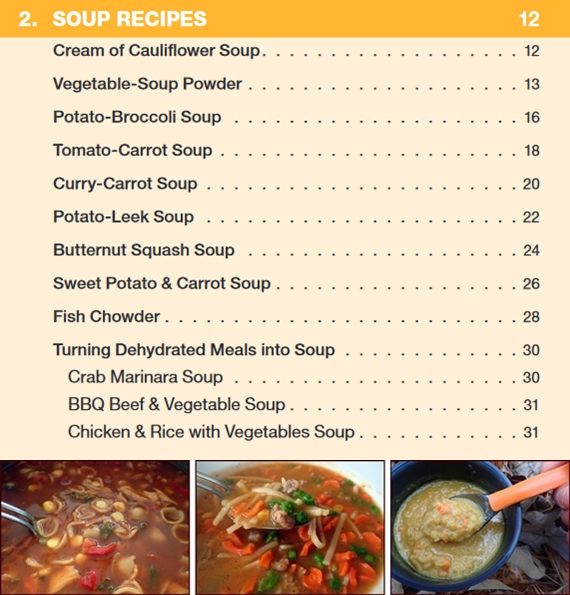
Explore more…
How to Dehydrate Beyond Burger for Vegetarian Chili, Unstuffed Peppers, and Taco Tortillas.
Textured Vegetable Protein Recipes.
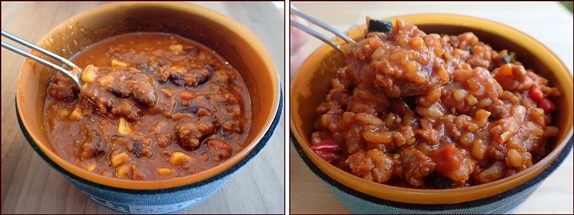
How to Dehydrate Vegetables for vegetarian backpacking meals.
Purchase Recipes for Adventure books.

Share this page with friends on social media.
Free E-book & Newsletter
Free with Trail Bytes subscription.
